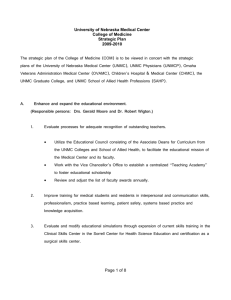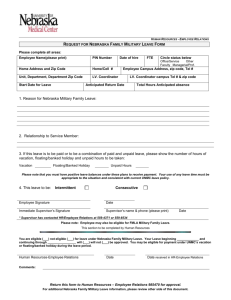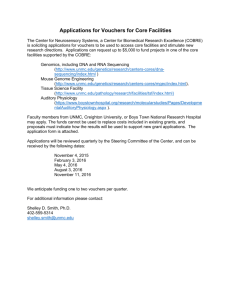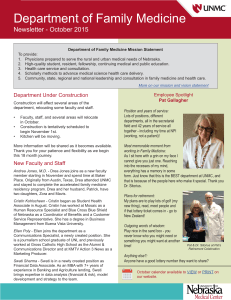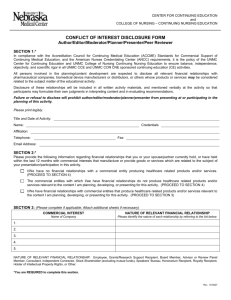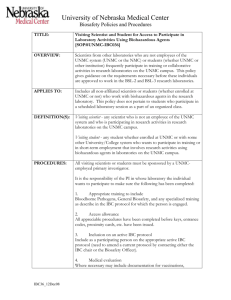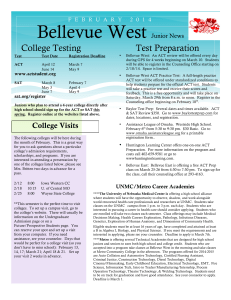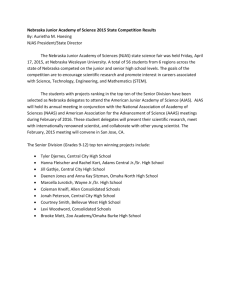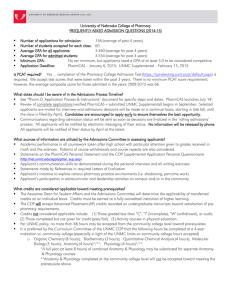University of Nebraska Medical Center
advertisement
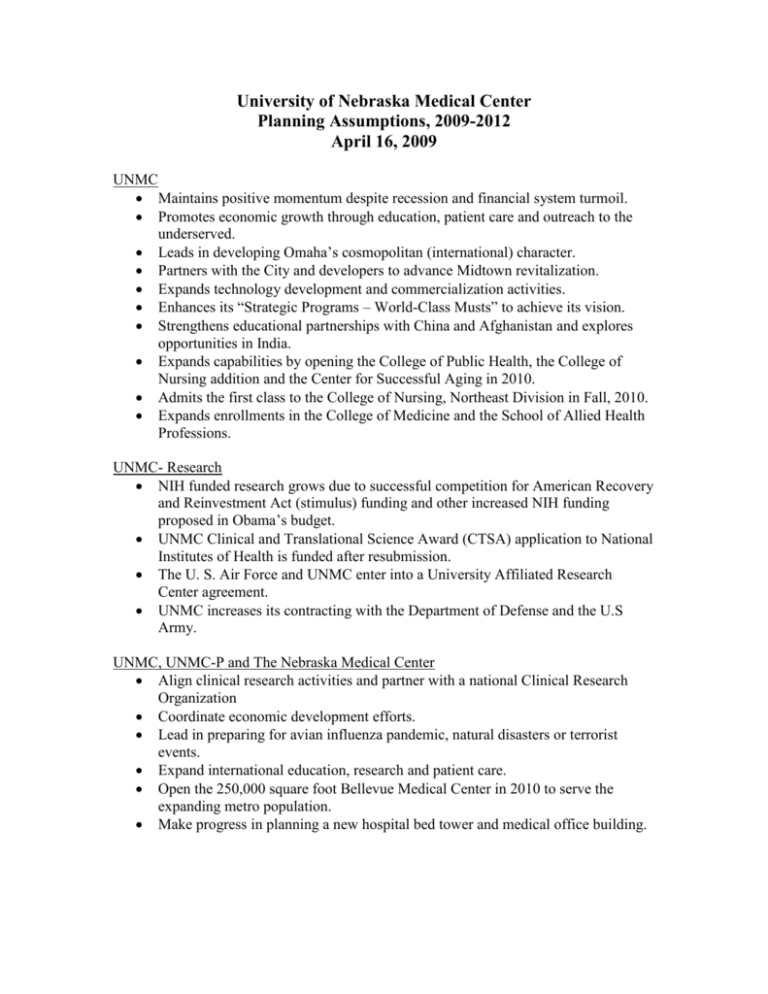
University of Nebraska Medical Center Planning Assumptions, 2009-2012 April 16, 2009 UNMC Maintains positive momentum despite recession and financial system turmoil. Promotes economic growth through education, patient care and outreach to the underserved. Leads in developing Omaha’s cosmopolitan (international) character. Partners with the City and developers to advance Midtown revitalization. Expands technology development and commercialization activities. Enhances its “Strategic Programs – World-Class Musts” to achieve its vision. Strengthens educational partnerships with China and Afghanistan and explores opportunities in India. Expands capabilities by opening the College of Public Health, the College of Nursing addition and the Center for Successful Aging in 2010. Admits the first class to the College of Nursing, Northeast Division in Fall, 2010. Expands enrollments in the College of Medicine and the School of Allied Health Professions. UNMC- Research NIH funded research grows due to successful competition for American Recovery and Reinvestment Act (stimulus) funding and other increased NIH funding proposed in Obama’s budget. UNMC Clinical and Translational Science Award (CTSA) application to National Institutes of Health is funded after resubmission. The U. S. Air Force and UNMC enter into a University Affiliated Research Center agreement. UNMC increases its contracting with the Department of Defense and the U.S Army. UNMC, UNMC-P and The Nebraska Medical Center Align clinical research activities and partner with a national Clinical Research Organization Coordinate economic development efforts. Lead in preparing for avian influenza pandemic, natural disasters or terrorist events. Expand international education, research and patient care. Open the 250,000 square foot Bellevue Medical Center in 2010 to serve the expanding metro population. Make progress in planning a new hospital bed tower and medical office building. Omaha and the Metropolitan Area Omaha’s new $140 M baseball stadium opens as scheduled in April 2011; downtown, riverfront and midtown economic revitalization continue. Construction of a new Omaha Veterans Administration hospital is approved. Metro area population grows and becomes more racially and ethnically diverse. Dodge/Saddlecreek intersection and traffic flows on Harney, Farnam and 42nd Streets are resolved. Omaha Chamber of Commerce pursues business investment and employment growth as its key economic development objectives. The Douglas and Sarpy Counties Learning Community very gradually reduces economic and social segregation. Building Bright Futures improves high school graduation rates and college attendance by low-income students. Nebraska Cows 1.9 M (2nd most) continue to outnumber people 1.7 M (38th highest) on our state’s 77,358 square miles (16th biggest). NU competes with Nebraska’s 93 counties, 446 townships, 531 municipalities, 575 public school districts and various other political subdivisions for state and citizen support. The population ages and becomes more racially and ethnically diverse, but the recession slows migration. Nebraska Medicaid reform is “deliberate and deliberative” – enrollment and state general fund costs are gradually reduced. Governor Heineman leads efforts to increase overseas trade. Creative use of federal stimulus funds, prudent use of the Cash Reserve Fund, and careful budgeting allow the State to avoid significant 2009-10 budget reductions. University and Foundation Moderate enrollment growth produces additional revenue at some campuses. General tuition increases are limited in order to maintain “affordability,” but UNMC is granted approval to increase selected professional program tuition rates to peer averages. Faculty and staff salary increases are a priority, but the recession poses major funding problems. Major fund raising proceeds slowly during the recession. Strategic Framework establishes NU priorities and guides action. NU effectively pursues its commitment to diversity and opportunity while fully complying with Initiative 424. Regional and National Deep recession continues for most of 2009; slow recovery is underway in 2010, but unemployment continues to rise during the first quarter of 2010. Financial disruptions gradually subside as the Obama team, the Federal Reserve, and other national governments stabilize and reconstruct financial institutions. Moderate to severe inflation replaces deflation as the ratio of national debt to GDP increases from its current level of 76% ($10.9 trillion/ $14.3 trillion) due to large deficits overwhelming low economic growth. Obama leads limited health care reform that slows expenditure growth beyond its current $2.4 trillion level and decreases the number of uninsured from 48 million. With Hispanic children making up roughly 25% of kindergarteners, minority children become the majority by 2023. The U.S. successfully disengages from Iraq but remains deeply committed in Afghanistan. The states take an active role in addressing health disparities, with 31 having adopted plans to reduce health disparities among minority populations. International China fares better than other nations during the global recession, emerges as a strong economic competitor and gradually recognizes that lowering its trade surplus with the U.S. serves its own national interest. Aging populations pose challenges for Europe, China, Russia, Ukraine and the U.S., while some African, Asian and Middle Eastern countries such as Mali, the Philippines and Yemen struggle with high fertility rates. U.S. Congressional action on a climate bill prior to the December opening of the Denmark round of global climate treaty negotiations is unlikely, and little international progress is expected before 2012. Oil prices more than double in 2010 as global economic activity revives. “The biggest challenge [India] is facing today is accessibility and affordability of quality healthcare services,” said Ms Preetha Reddy, Managing Director, Apollo Hospitals at the February 21, 2009, Health Summit , organised by Confederation of Indian Industry. n\planning\2009-10\econ growth planning assumptions.doc
